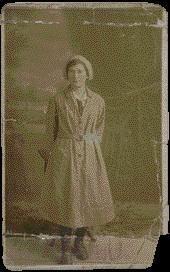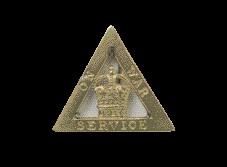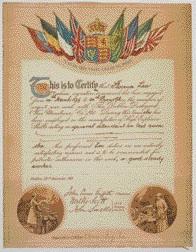From sewing needles to ammunition shells
Published in 20th-century / Contemporary History, Features, Issue 1 (Jan/Feb 2009), Volume 17, World War I The story of Florence Lea (right), who wore this ‘On War Service’ badge (above right), is typical of the experiences of female munitions workers in Ireland during World War I. Their story is represented in the ‘Soldiers and Chiefs’ exhibition at the National Museum of Ireland by the 18-pounder shells they made, the photos of them proudly wearing their uniform and the mementoes of a munitions worker’s life cherished by Florence. Florence was the eldest of three children; her father, John, was an iron-moulder, and in 1911 the family lived at 5 Tritonville Road, Sandymount. She was an apprentice dressmaker at the beginning of the war, earning just 2 shillings per week. The war initially had a disastrous effect on the trades of non-essential goods; in particular, seamstresses were affected in Dublin and Florence may have lost her job. Florence’s ‘Urgent War Work Certificate’ (below right) states that from 14 March 1917 to 20 December 1918 she worked as a general attendant in the test room of the Dublin Dockyard Company’s Munitions Works. Its workforce of c. 200 were mostly women since the War Ministry did not allow munitions companies to employ more than five per cent men and boys.
The story of Florence Lea (right), who wore this ‘On War Service’ badge (above right), is typical of the experiences of female munitions workers in Ireland during World War I. Their story is represented in the ‘Soldiers and Chiefs’ exhibition at the National Museum of Ireland by the 18-pounder shells they made, the photos of them proudly wearing their uniform and the mementoes of a munitions worker’s life cherished by Florence. Florence was the eldest of three children; her father, John, was an iron-moulder, and in 1911 the family lived at 5 Tritonville Road, Sandymount. She was an apprentice dressmaker at the beginning of the war, earning just 2 shillings per week. The war initially had a disastrous effect on the trades of non-essential goods; in particular, seamstresses were affected in Dublin and Florence may have lost her job. Florence’s ‘Urgent War Work Certificate’ (below right) states that from 14 March 1917 to 20 December 1918 she worked as a general attendant in the test room of the Dublin Dockyard Company’s Munitions Works. Its workforce of c. 200 were mostly women since the War Ministry did not allow munitions companies to employ more than five per cent men and boys.
The war brought inflation, as well as rationing of items like jam and butter, but it would also generate business for Irish companies. Contracts were awarded to companies all over Ireland, including one worth £11 million for 50,000 miles of aeroplane cloth. Smaller contracts were issued for leather accoutrements to the Enniscorthy Agricultural Co-operative and for blankets to woollen mills such as in Foxford, Co. Mayo, and Crumlin, Co. Antrim; uniforms were manufactured in Dublin, Belfast and Limerick. Harland and Wolff gained some of the largest manufacturing contracts. The worst Irish manufacturing disaster of the war was at the high explosive plant Kynoch’s in Arklow, when 27 workers were killed in an explosion on 21 September 1917. Every week this plant manufactured 100 tons of cordite and had a workforce of over 2,000 (see HI 14.1, Jan./Feb. 2006, pp 30–5).
 During the war, five ‘national munitions factories’ were set up in Dublin, Cork, Waterford and Galway, employing 2,148 men and women. Women recruited to these factories were unionised by the British-based National Federation of Women Workers. They had members in Cork, Galway, Derry, Waterford and Wexford. This union and its members forced Irish employers to adhere to the government regulation of a minimum wage of £1 per week for women in government-controlled employment. This was no small achievement, since under the Munitions of War Act (1915)—which covered all munitions companies, public and private, producing material for the army—strikes, lockouts and stoppages were banned and 21 days’ notice of disputes was mandatory. One of the union’s most significant successes was the Special Arbitration Tribunal for Women Employed on Munitions Works, held at the Shelbourne Hotel, Dublin, in April 1918, which raised rates and war bonuses not only for shell workers but also for canteen, cloakroom and cleaning staff. By November 1918 the women were earning £1-4-0 per week, and some earned more: Florence earned 50 shillings per week, albeit for a 48-hour week involving shift work.
During the war, five ‘national munitions factories’ were set up in Dublin, Cork, Waterford and Galway, employing 2,148 men and women. Women recruited to these factories were unionised by the British-based National Federation of Women Workers. They had members in Cork, Galway, Derry, Waterford and Wexford. This union and its members forced Irish employers to adhere to the government regulation of a minimum wage of £1 per week for women in government-controlled employment. This was no small achievement, since under the Munitions of War Act (1915)—which covered all munitions companies, public and private, producing material for the army—strikes, lockouts and stoppages were banned and 21 days’ notice of disputes was mandatory. One of the union’s most significant successes was the Special Arbitration Tribunal for Women Employed on Munitions Works, held at the Shelbourne Hotel, Dublin, in April 1918, which raised rates and war bonuses not only for shell workers but also for canteen, cloakroom and cleaning staff. By November 1918 the women were earning £1-4-0 per week, and some earned more: Florence earned 50 shillings per week, albeit for a 48-hour week involving shift work.
 Despite the power of the unions and the demonstration by women of their suitability to work in manufacturing, the encroachment of women into non-traditional roles did not last. By the summer of 1919 the national shell factories had been sold and the majority of Irish women, including Florence, returned to more traditional workplaces and trades. HI
Despite the power of the unions and the demonstration by women of their suitability to work in manufacturing, the encroachment of women into non-traditional roles did not last. By the summer of 1919 the national shell factories had been sold and the majority of Irish women, including Florence, returned to more traditional workplaces and trades. HI
Siobháin Pierce is Assistant Education Officer at the National Museum of Ireland, Decorative Arts and History, Collins Barracks.
From sewing needles to ammunition shells
Siobháin Pierce tells the story of Florence Lea’s
‘On War Service’ badge
















